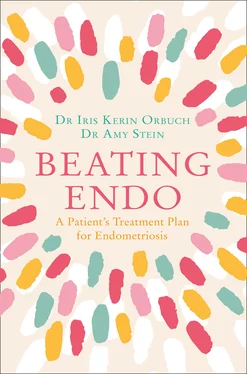Until, drawing not only on our own expertise and experience but also on that of scores of other practitioners, we devised a multifaceted and integrated approach that beats the disease known as endometriosis, an approach that gets past precisely what was afflicting these patients. The approach does not cure endometriosis; there is not yet a known cure. But it does empower those who have the disease to keep it from taking over their lives so they can reclaim the quality of life they want and deserve.
We don’t remember precisely when and how we first connected across the gap between our separate professional silos. It’s a bit puzzling because the healthcare community in New York City, where both of us began our careers, is still a closely defined world in which practitioner names are exchanged swiftly and easily along lines of shared professional focus. We suspect that we might have been introduced to or encountered each other or at least have noted each other’s name tags at a large and busy conference about pelvic pain, a key marker of endo. Or it’s possible that a colleague known to us both suggested a patient referral to the other—a sort of secondhand and oblique connection.
But however vague its origins, what forged the connection could not have been more compelling. By the time we did finally find each other, the suffering that endometriosis caused in our patients was very much on both of our minds, and each of us had concluded that a new and more comprehensive way to confront this disease was needed.
Our individual journeys to this conclusion help explain how we were able to create the integrated, multimodal approach to beating endometriosis that is the focus of this book. It’s a pair of stories worth telling.
THE GYNECOLOGIST
Iris is the daughter of a cardiologist father. Medicine as a calling was no abstraction when she was growing up; it was more or less the air she breathed. From watching her father at work, she learned what became a mantra for her own future practice: first listen, then examine. Hear what the patient is telling you, then probe the body.
Iris carried the mantra with her through college and medical school to her residency in obstetrics and gynecology at Lenox Hill Hospital in New York City. Along the way, she married a fellow gynecologist, and she had her first child, a daughter; a second daughter would follow three years later.
Meanwhile, her residency completed, Iris went on to a fellowship in Advanced Laparoscopic and Pelvic Surgery with Dr. Harry Reich and Dr. C. Y. Liu, pioneers in endometriosis excision surgery. It was an incredible opportunity to work in their technologically advanced operating room, but what made the fellowship really special was the tutelage of the two men who had made significant advancements in the minimally invasive procedure that is the only proper treatment for the disease—excision surgery that cuts out of the body the misplaced tissue that caused the endo and confirms the presence of the disease. Reich and Liu mentored the young woman who shared their passion for the surgery they had perfected. Like her father, they listened closely to their patients. Sitting beside one or the other of them day after day as they heard patients tell of their pain and indeed their fears became for Iris an unforgettable introduction to the very real suffering that endo inflicted.
In 2005, Iris began her own practice, often operating along with Dr. Liu in those early years. Like her mentors, she made excision surgery her signature procedure, and as both they and her father had taught her, she spent whatever time it took to listen to her patients. The more she heard about their debilitating pain, overreliance on opioids and other painkillers, bladder and bowel ailments that seemed never to go away, pain during sex, depression—and sometimes all of those things together—the more she committed herself to doing whatever it took to restore their quality of life.
The issue became even more pressing when Iris read about a study 1that had tracked the long-term progress of women who had undergone excision surgery. The finding that particularly resonated was an almost passing remark in the discussion that even after “meticulous removal of all endometriosis,” a number of patients continued to be “symptomatic.” The removal of the endo tissue was not, as both patients and doctors had hoped, a complete cure. Instead, noted the study, “another cause of (a patient’s) pain should be considered.” To Iris, this statement struck a chord, prompting her to consider whether surgery alone was enough; perhaps more was needed if these patients were to regain the quality of their lives.
The study ignited Iris’s intellectual curiosity even as it touched a deep emotional chord. The question seemed simple: What was keeping these women from getting 100 percent better? What was the final piece of the puzzle that would return them to the kind of robust vigor and well-being their age and their dreams required? The medical literature offered no answers, while research findings reported at medical conferences focused on technology and drugs—and seemed to Iris to miss the point. She reviewed patterns of symptoms that her patients told her kept recurring—rectal spasms, shooting pains down the legs, pain after sex that lasted hours and sometimes days and ultimately produced anxiety and depression—but was unable to uncover any explanation. The question haunted her. Despite all the firepower being aimed at endometriosis, why were women still suffering?
THE PHYSICAL THERAPIST
At a similar point in her career, Doctor of Physical Therapy Amy Stein was asking herself the same question, arrived at along a somewhat different trajectory. As a little girl growing up in a suburb along Philadelphia’s Main Line, Amy thought she might like to become a veterinarian one day. College changed all that; by her own count, she went through five majors, eventually getting a degree in Spanish literature before going on to a master’s in physical therapy. The doctorate took a little longer, thanks to her giving birth to two kids two years apart, and to her expanding medical practice—she opened her first private office in 2003, her second in 2018—and her growing prominence as a pioneering expert in addressing pelvic pain through biomechanics, manual therapy, and stretching and strengthening exercises. *Yet from the vantage of that expertise, she found herself puzzled by a particular group of patients whose pain did not improve further once they had reached a certain plateau.
* Amy is the author of Heal Pelvic Pain , published in 2008 by McGraw Hill; she has served since 2008 on the board of the International Pain Society and as its president in 2017.
Like Iris, who flouted much of standard medical practice by spending all the time needed to listen to her patients—well over the times “assigned” by insurance or hospital guidelines—Amy began her therapeutic approach by considering the whole body. To Amy, that meant hearing and, as physical therapists do, literally touching a patient’s pain.
But also like Iris, Amy found herself perplexed by the group whose progress seemed to slow and then virtually come to a halt once they got past a particular point. She was disheartened too by the misdiagnoses and subsequent medical mismanagement she observed in so many of those patients. Most had been referred to her following considerable time in treatment by urologists, gynecologists, colorectal specialists, gastroenterologists, or orthopedists; some of them had undergone surgery—sometimes unnecessarily. Many had been diagnosed with irritable bowel syndrome or interstitial cystitis, as it was then called—painful bladder syndrome as it is better known today—or with urinary dysfunction or just with pain . Some had been told they had a mental health disorder. Many had been prescribed unnecessary medications that resulted in greater dysfunction, and far too many had been prescribed opioids that had brought minimal and temporarily relief at best—and which became problematic in other ways.
Читать дальше











